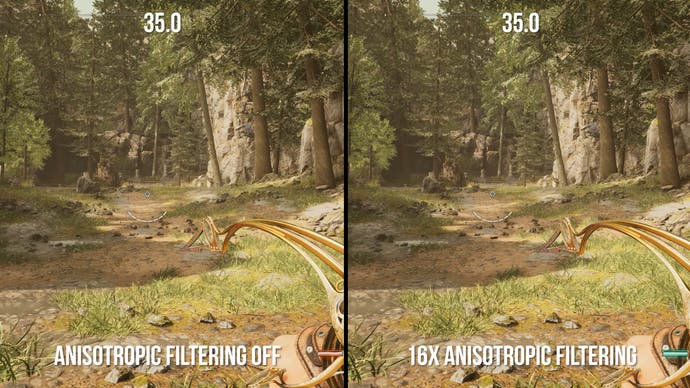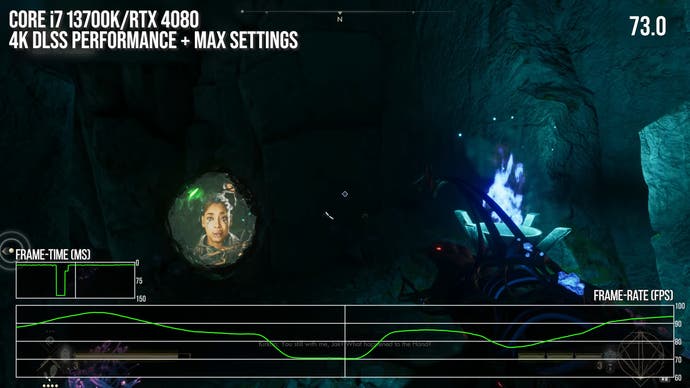Even if you're not into the fantasy aesthetic or shooters in general, Immortals of Aveum is still an interesting title. The game is powered by Unreal Engine 5.1 and is the first triple-A title to simultaneously take advantage of several signature UE5 features in order to bring its world to life. Ahead of our look at the game's tech, this article's focus is PC performance.
After all, the release of the game's system requirements ahead of launch raised some eyebrows. The minimum spec calls for an RTX 2080 Super (a $699 graphics card in 2019), backed with an eight-core CPU and ideally an SSD too... and that's only for a 1080p 60fps experience. The recommended specs are even more jaw-dropping, with an RTX 3080 Ti ($1199 in 2021) and Ryzen 7 5700X ($299 in 2022) representing an acceptable level of horsepower for 1440p 60fps gaming - and both of these spec points assume the use of upscaling using DLSS or FSR 2 to boost performance, with native performance likely significantly lower.
Given what we've seen of Unreal Engine 5's performance in real-time demos, the high specs do make some sense - but they're undeniably high. For context, last month's Steam Hardware Survey shows nearly 60 percent of CPUs represented have fewer than eight cores, and only a tiny fraction of graphics cards are equal or better than a 2080 Super. As I have three machines that are pretty close to the suggested 1080p, 1440p, and 4K builds, I thought I'd put the game to the test on each and find out how accurate the recommended specs are in what must be one of the most challenging PC games ever released.
Immortals of Aveum does give a positive first impression, with skippable logos, adjustable FOV (albeit only up to 90 degrees) and a good range of options for accessibility and graphics. Unfortunately, these settings lack preview images or text descriptions that could hint towards their performance and visual impact. Certain options, like texture quality, unfortunately require a complete game restart which makes things quite tedious. Those with ultrawide monitors will also be pleased to know the game natively supports those resolutions, and resizes the HUD accordingly during gameplay.
There's also a unique performance budget tool, which is meant to help you select the appropriate settings for your hardware by testing your single-core CPU and overall GPU performance, giving you a score that reflects your resources, and then encouraging you to select settings to stay within those bounds. This is a nice addition, though 16x AF was mistakenly presented as having a huge performance impact despite being essentially free on modern GPUs - a simple enough oversight but a glaring one that needs fixing.
Our first build to test had an Nvidia RTX 4080 and Intel Core i7 13700K, therefore lining up well with developer Ascendant's recommendations for 4K 60fps gameplay. This build was indeed able to stay around 60fps or above with maxed settings for much of gameplay, though DLSS quality mode wasn't sufficient for large areas with plenty of characters - and I eventually had to drop to DLSS performance mode to iron things out completely.
DLSS 3 frame generation is available for users of 40-series graphics cards, but it's practically unusable at present due to a ghosting effect applied to the game's HUD - something that persists even after the game's first patch. Thankfully, standard DLSS 2 is sufficient for most cases, and the only other issues I noticed were some distracting pop-in and a few stutters here and there - thankfully not of the shader compilation variety, instead being related to traversal or and normally relagated to non-combat moments.
Interestingly, Immortals also supports FSR 2, which is more detailed than either native or DLSS - suggesting it has a different LOD bias, a sharpening filter, or both, included. However, DLSS offers a more stable experience, with better handling of fast-moving objects (eg when swapping weapons). That's with both upscalers set to their quality modes; at performance mode DLSS is still fine but FSR 2 becomes so murky that it's hard to recommend.
Overall, the suggested specs for a 4K60 experience seem to be accurate - but fixing DLSS 3 would make a big difference.

Moving down to a PC closely aligned with the recommended 1440p 60fps spec, I saw much of the same - largely, anyway. With an RTX 3080 Ti and Ryzen 9 5900X, I managed to stay around 60fps practically the entire time with a mix of high and ultra settings and DLSS quality mode engaged. I experienced some minor hitching here and there, but nothing significant in any of the footage I captured. All in all, like the recommended specs for 4K60, these also seem to be pretty accurate.
The machine a touch below the minimum requirements - RTX 2080 and Ryzen 5 3600 - provided the most interesting results. This combination often provides console-level performance, and we know that the PS5 version of Immortals runs at an internal resolution of 720p at 60fps, with drops possible in more demanding areas. Perhaps unsurprisingly, we see similar results at 1080p with DLSS quality on this machine (a setting that results in a matching 720p internal resolution). The game appears CPU-bound on this hardware even on lowest settings, with frame-rates dipping into the 40s and GPU utilisation well below 100 percent. Traversal stutter was also much worse, with one freeze lasting for a full second. Therefore, it might make sense to set everything to high and target a capped 30fps instead.
Out of curiosity, I tried to figure out what settings the PS5 version is using. Textures appear to be at ultra, while global illumination appears to be close to low. Everything pertaining to Shadows appears to be mostly equal to high, and reflections seem to be closer to low than high. Unfortunately, I found other settings difficult to pinpoint, and PS5 may be using settings that don't correspond to the PC presets.

As far as choosing optimised settings, truthfully they don't make sense on the 1080p-focused PC, as even the lowest settings can't hold 60fps on our mid-range system. With that in mind, I took a bit of time going through each setting on the high-end RTX 4080 system instead. Here, I saw only three settings with any notable impact on performance: global illumination, shadow resolution quality, and shadow rendering pool size. Changing these three options from ultra to high provided a 10 percent frame-rate boost without significant visual degradation.
Before wrapping up, I decided to see how the game fares on hardware more in line with what we saw on the Steam Hardware Survey, so I broke out my old PC equipped with a GTX 1080 and a quad-core Intel i7 7700K. What I found was interesting - at 1080p with FSR 2 quality, high textures and everything else set to low, the game actually remained above 30fps in some pretty demanding areas, at least until I walked through some trees and the frame-rate tanked to the low 20s. So, the game is still playable on hardware well below the minimum spec, but you will be stuck with the lowest settings, and 30-40fps at best. Again, capping things at 30fps to maximise consistency could be the best option, though poor frame-pacing from the in-game's 30fps cap (with v-sync active) isn't great.
In summary, the high system requirements for Immortals of Aveum are absolutely genuine. It is an incredibly heavy game that requires an above-average PC to even come close to maintaining the developer's intended 60fps experience. On the upside, the system requirements actually provide an accurate assessment of what you can expect from a raw performance standpoint. On the downside, a few outstanding issues, like traversal stutter, keep the game from reaching its full potential. Here's hoping the developers are able to fix these issues in future patches, unlike some other recent EA-published releases.
https://news.google.com/rss/articles/CBMigwFodHRwczovL3d3dy5ldXJvZ2FtZXIubmV0L2RpZ2l0YWxmb3VuZHJ5LTIwMjMtaW1tb3J0YWxzLW9mLWF2ZXVtLWNhbi1tb2Rlcm4tcGNzLWFjaGlldmUtYmV0dGVyLXBlcmZvcm1hbmNlLWFuZC12aXN1YWxzLXRoYW4tY29uc29sZdIBAA?oc=5
2023-08-29 14:58:10Z
CBMigwFodHRwczovL3d3dy5ldXJvZ2FtZXIubmV0L2RpZ2l0YWxmb3VuZHJ5LTIwMjMtaW1tb3J0YWxzLW9mLWF2ZXVtLWNhbi1tb2Rlcm4tcGNzLWFjaGlldmUtYmV0dGVyLXBlcmZvcm1hbmNlLWFuZC12aXN1YWxzLXRoYW4tY29uc29sZdIBAA
Bagikan Berita Ini














0 Response to "Immortals of Aveum on PC: a demanding game with big hardware requirements - Eurogamer.net"
Post a Comment